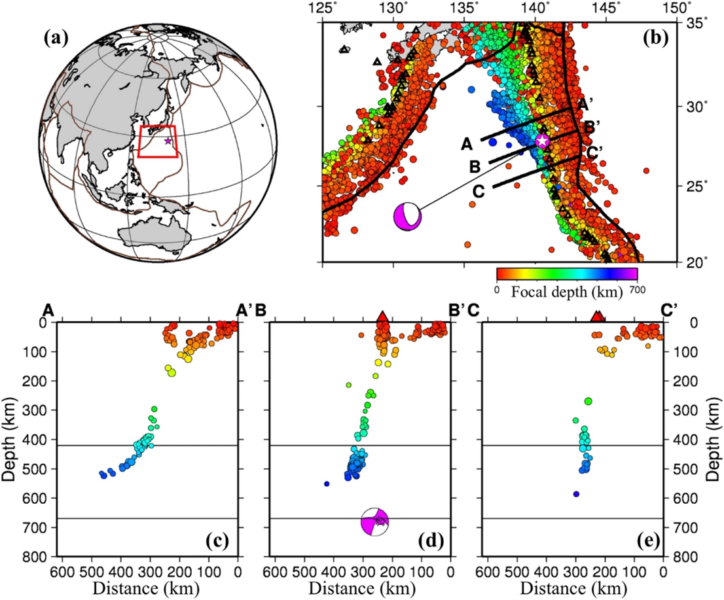Contact Us
Tuesday 4th July 2023 | Blog written by Neil McLauchlan, Route Engineer

Convergent plate boundaries are locations where tectonic plates are moving towards each other. Convergence can occur at oceanic-oceanic, oceanic-continent and continent-continent boundaries. In oceanic-oceanic convergences, the older more dense plate usually subducts under the younger more buoyant plate (Mariana). In oceanic-continent convergences, the dense oceanic plate is subducted under the buoyant continental plate (Andes). Continent-continent collisions are more complex and form a compression zone as subduction of any oceanic crust stops, this causes crustal thickening and raises mountains (orogeny) through isostasy (Himalayas).

In subduction zones, trenches form between the subducting crust and the accretionary wedge of the overriding crust. Generally, these trenches are at least double the depth of the subducting oceanic plate. The deepest trench, the Mariana Trench, reaches approximately 11km in depth. The accretionary wedge comprises sediments that demonstrate reverse (thrust) faulting as they get compressed on the overriding plate. When engineering a route around a trench it is prudent to know the movement rate of the surrounding plates and the life expectancy of the cable. Also, accretionary wedges are susceptible to sediment transport as faulting creates an environment capable of extension as well as compression.
As the oceanic lithosphere is subducted into the mantle it pushes against the overriding crust and can become wedged. As the pressure builds, the latent energy builds. When the energy is released, it can cause fractures which produce a series of earthquakes along a planar zone of seismicity, known as the Wadati-Benioff zone. Subduction zones are known to cause the highest magnitude earthquakes. Earthquakes can cause several hazards to cable routes: liquefaction can occur in seafloor sediments causing the cable to be buried deeper or exposing it at the surface; movement of sediment in landslides can damage the cable as deposition occurs; landslides can cause tsunamis which can also cause damage to cables.

Volcanoes are created at convergent boundaries when the subducting plate brings volatiles, such as water, into the aesthenosphere which reacts with the overriding plate creating magma. Generally, magma at convergent boundaries creates explosive stratovolcanoes. Volatiles significantly reduce the melt temperatures of peridotite in the mantle, they also increase the pressure as they transition to a gaseous phase. Volcanic arcs are most dangerous to submarines cables when present on oceanic plates. Although continental volcanoes can affect cables through the likes of landslides near the coast caused by eruptions and tephra flowing into the ocean causing damage to the cable. Especially if the topography is favourable for channels.
References:
BGS, 2022. What causes earthquakes? British Geological Survey. Available at: https://www.bgs.ac.uk/discovering-geology/earth-hazards/earthquakes/what-causes-earthquakes/
GeolSoc, 2022. Plate Tectonics. The Geological Society. Available at: https://www.geolsoc.org.uk/Plate-Tectonics
Johnson, C., et al., 2017. An Introduction to Geology. Chapter 2 Plate Tectonics. Salt Lake Community College. Available at: https://opengeology.org/textbook/
King, H., 2005. Plate Tectonics. Geology.com. Available at: https://geology.com/plate-tectonics/
NOAA, 2022. What are the different types of plate tectonic boundaries? National Oceanic and Atmospheric Administration: Ocean Exploration. Available at: https://oceanexplorer.noaa.gov/facts/plate-boundaries.html
USGS, 2014. Understanding plate motions. US Geological Society. Available at: https://pubs.usgs.gov/gip/dynamic/understanding.html
van Andel, T. H., 2022. Plate tectonics. Encyclopaedia Britannica. Available at: https://www.britannica.com/science/plate-tectonics Zhao, D., et al., 2017. Tomography of the subducting Pacific slab and the 2015 Bonin deepest earthquake (Mw 7.9). Scientific Reports. Vol 7, article no. 44487.

Neil is one of OceanIQ’s experienced Route Engineers